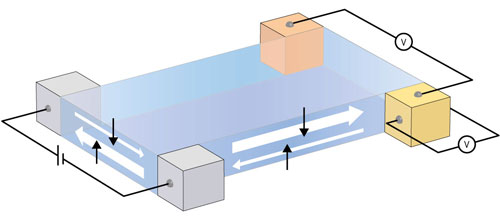| Posted: Sep 04, 2015 |
Spins on the edge
(Nanowerk News) A model system that could allow a range of electron-spin-related phenomena to be experimentally observed—an important step toward realizing practical ‘spintronic’ devices—has been proposed by RIKEN researchers ("Charge and spin transport in edge channels of a v = 0 quantum Hall system on the surface of topological insulators").
|
 |
| Measuring the voltages between different pairs of electrodes around a thin film topological insulator could reveal how electron spins behave under magnetic and electric fields. The thick white arrows represent spin-resolved current flow, while the thin black arrows represent the spin polarization. The imbalance between the spin-up and spin-down currents indicates that a net spin current flows along the edges of the topological insulator thin films. (© American Physical Society)
|
|
Conventional microelectronic circuits process data by shuttling and manipulating the electric charges of electrons. But electrons have another property that is highly promising as a basis for data processing and storage—spin. Circuits based on spin have the potential to be much faster, more efficient and smaller. However, it is much harder to control electron spin than charge, and very specific material systems are required.
|
|
Naoto Nagaosa of the RIKEN Center for Emergent Matter Science and his colleagues from the RIKEN Condensed Matter Theory Laboratory have been studying how electron spins behave in an unusual class of materials known as topological insulators. Such materials are electrically insulating internally but highly conductive on their surfaces. One consequence of this character is that the pattern and flow of spins at the surface could be manipulated relatively easily. “Topological insulators could be an ideal laboratory for spintronics,” says Nagaosa.
|
|
To investigate, the research team performed calculations related to the exposure of a thin film to a strong magnetic field at very low temperatures. This induces the formation of discrete spin-dependent energy levels and results in a voltage that increases in steps as the magnetic field rises—a phenomenon known as the quantum Hall effect.
|
|
These conditions are predicted to open up a ‘channel’ along the edges of a topological insulator film, along which electrical charges and spins could flow. The team also found that electric fields could be used to generate more spins in the channels. “These edge channels can support interesting charge- and spin-transport phenomena, which we believe will provide many useful spintronics functions,” notes Nagaosa.
|
|
The researchers propose measuring these effects in an experiment involving a thin film of a topological insulator with an electrode at each corner (Fig. 1). The voltage between two of these electrodes would register charge transport, while the voltage between two sides of one of these electrodes would reveal the spin current. Applying an external electric field would then generate spins that could be recorded by the other two electrodes.
|
|
“Quantum Hall effects in topological insulator thin films have already been observed by a couple of experimental groups, including one at RIKEN,” says Nagaosa “so we hope that spintronic functions in these thin films will be achieved in the near future.”
|

